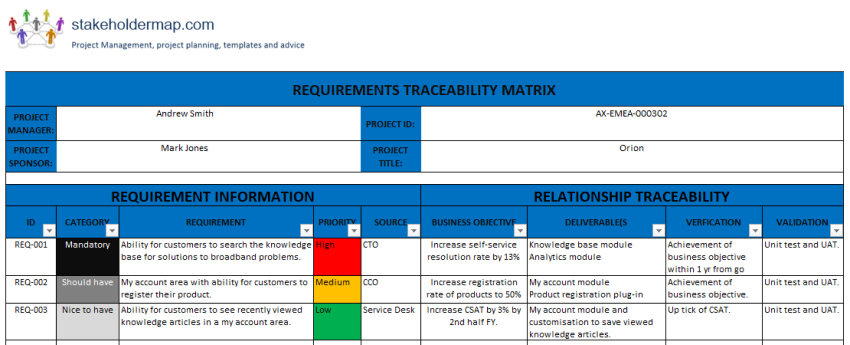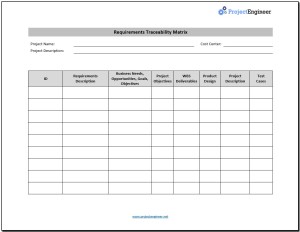
The goal here is to eliminate extras such as unnecessary code, design features or tests.

It makes sure the product answers the requirement, and you have tested it methodically. Forward traceability: This type of RTM traces the project’s progress in building the right product.Forward traceability, backward traceability, and bi-directional traceability. There are three different types of Requirements Traceability Matrix. What are the different types of Requirements Traceability Matrix? Importantly, you will be able to confirm the product is working properly, and it meets the original business requirements. You will also be able to check if the tests found any defects, and whether you have fixed them. Using the RTM, you can confirm that all requirements have passed all relevant tests. The RTM will help to trace all the project requirements through the testing process. Bugs: what bugs, if any, have shown up in testing.Testing: where the requirement is in the testing phase.Business need: what need is the requirement meeting (a short sentence here is enough).Brief description of the requirement: what is it? (a couple of words is enough).Once you have a basic template in place you can adjust it where necessary for different projects. It can contain as few or as many columns as you need. Step 3: Create a template for your Requirements Traceability MatrixĪrmed with all the relevant information, you will be able to create a template for your RTM.
REQUIREMENTS TRACEABILITY MATRIX SOFTWARE
Setting test cases is an important part of software development projects. Now you can make a complete RTM with all the relevant information, from client requirements to test cases information. You will need access to key documents, including the Business Requirement Document, Functional Requirement Document, Technical Requirement Document and a Statement of Work. Step 2: Gather all of the relevant documents What are the objectives of the project? These are based on the client’s expectations, and you will need to clearly define them from the outset. Here are the four steps to creating your Requirments Traceability Matrix. It acts as a guide for the project and sets the scene for the project manager.
REQUIREMENTS TRACEABILITY MATRIX HOW TO
How to create a Requirements Traceability MatrixĪ Requirements Traceability Matrix should be one of the first tasks of any project. This is particularly important if requirements overlap and need to be integrated with each other at a later stage. In a team environment, it’s important that everyone knows who’s doing what and how each task is progressing. Transparency is a key characteristic of a successful project. It also provides a clear picture of each specific requirement and maps out progress on the deliverables. By creating an RTM at the beginning of each project, your team can lay the foundations for the project’s scope. The RTM identifies all client requirements and maps out progress from the beginning of the project all the way through to the final product.Ī Requirements Traceability Matrix helps to ensure a project’s scope, requirements and deliverables do not extend beyond the initial brief. It visually draws a clear path between these two. Its simple interface shows at a glance what has been done and what needs to be done. What is a Requirements Traceability Matrix?Ī Requirements Traceability Matrix (RTM) is a table or chart that identifies and tracks a project’s requirements and deliverables. This is where a requirements traceability matrix comes into play. It’s also crucial that you align progress with client expectations and the project deadline. The main challenge is coordinating all of the requirements. Of course, every project is different, and some projects will be more complex than others. With so many elements to consider – from deadlines to deliverables – organization is key. In fact, the 2021 Project Management Report found that 59% of project managers regularly manage between two and five projects 11% oversee six to 10 projects, and 15% manage over 10 projects. Successful program managers will often be managing more than one project at the same time. It’s an invaluable, yet simple tool, that helps to navigate the program management process.

One such tool is a Requirements Traceability Matrix (RTM). A program manager will know when and how to use tools to support their own skills.

They effectively track the progress of each project and every requirement within a project. They also have a sure grasp of processes and are data focused. A successful program manager has excellent communication skills. There’s an art to effective program or project management.


 0 kommentar(er)
0 kommentar(er)
